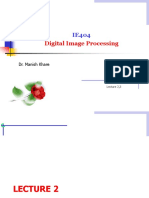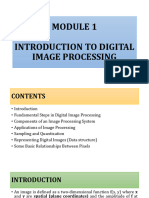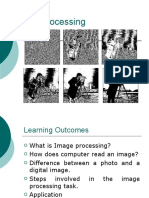0% found this document useful (0 votes)
8 views30 pages1 - Introduction and Applications
Digital Image Processing (DIP) involves the manipulation of digital images using computers, focusing on tasks such as noise reduction, contrast enhancement, and image segmentation. It utilizes various sources of images from the electromagnetic spectrum and has applications in fields like medical imaging, astronomy, and automated inspection. The document outlines the fundamental concepts, types of processing, and the importance of images in human perception and technology.
Uploaded by
varunrajvijayakumar2005Copyright
© © All Rights Reserved
We take content rights seriously. If you suspect this is your content, claim it here.
Available Formats
Download as PPTX, PDF, TXT or read online on Scribd
0% found this document useful (0 votes)
8 views30 pages1 - Introduction and Applications
Digital Image Processing (DIP) involves the manipulation of digital images using computers, focusing on tasks such as noise reduction, contrast enhancement, and image segmentation. It utilizes various sources of images from the electromagnetic spectrum and has applications in fields like medical imaging, astronomy, and automated inspection. The document outlines the fundamental concepts, types of processing, and the importance of images in human perception and technology.
Uploaded by
varunrajvijayakumar2005Copyright
© © All Rights Reserved
We take content rights seriously. If you suspect this is your content, claim it here.
Available Formats
Download as PPTX, PDF, TXT or read online on Scribd
/ 30




















































































